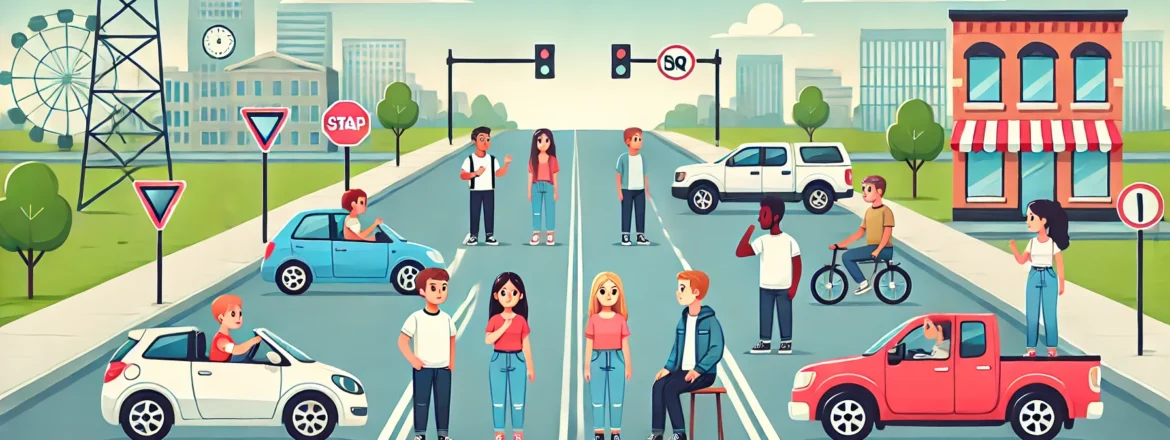Table of Contents
- Introduction to Defensive Driving
- What is Defensive Driving?
- Why is Defensive Driving Important for New Drivers?
- Top Defensive Driving Techniques for New Drivers
- Additional Tips for Defensive Driving
- Frequently Asked Questions (FAQs)
Introduction to Defensive Driving
Learning to drive is an exciting step toward independence, but with this new skill comes the responsibility of staying safe on the road. For new drivers, mastering defensive driving techniques is essential to keep themselves, their passengers, and others safe.
What is Defensive Driving?
Defensive driving is a set of driving strategies that help drivers anticipate and respond to potential hazards on the road. This approach goes beyond simply knowing how to handle the car; it’s about proactively adjusting your driving to avoid accidents and handle unexpected situations.
Why is Defensive Driving Important for New Drivers?
For new drivers, defensive driving techniques provide crucial skills that help prevent accidents, avoid traffic violations, and stay calm in stressful situations. New drivers can benefit by:
- Reducing accident risk: Learning to spot hazards early reduces the chance of accidents.
- Improving reaction times: Defensive driving practices teach drivers how to react effectively to sudden changes.
- Building confidence: Knowing how to manage potential dangers makes driving less intimidating.
Top Defensive Driving Techniques for New Drivers
1. Maintain a Safe Following Distance
Keeping a safe following distance gives you more time to react if the vehicle in front suddenly brakes. The “three-second rule” is a good standard to follow:
- Choose a stationary object (like a sign or tree) on the road ahead.
- As the car in front passes it, start counting seconds (“one-thousand-one, one-thousand-two…”).
- If you reach the object before you finish counting to three, you’re too close.
For beginners, maintaining a larger distance, especially in bad weather or at higher speeds, is recommended.
2. Stay Aware of Your Surroundings
Awareness is key to defensive driving. Constantly check your mirrors, blind spots, and the road ahead to stay alert to any potential hazards. Here are a few tips:
- Use mirrors frequently: Check your rearview and side mirrors every few seconds.
- Keep an eye on vehicles beside and behind you.
- Anticipate other drivers’ actions: Notice signals, brake lights, and speed changes.
3. Minimize Distractions
Distracted driving is one of the top causes of accidents. Common distractions include texting, talking on the phone, eating, and adjusting the car’s controls. As a new driver:
- Put your phone away: Consider putting it on silent or using “Do Not Disturb” mode.
- Adjust controls before you start driving.
- Keep conversations minimal with passengers, especially during complex driving situations.
4. Know and Follow Traffic Rules
New drivers should be well-versed in local traffic laws and adhere to them closely. Familiarity with traffic rules helps drivers make safer choices and reduces the chances of accidents.
- Understand the rules of right of way.
- Follow speed limits: Speed limits are there for safety, and exceeding them reduces reaction time.
- Yield to pedestrians and cyclists: Especially in crowded areas, be vigilant and courteous.
5. Expect the Unexpected
Being prepared for sudden changes can help you react quickly and safely. Expecting the unexpected is key to defensive driving.
- Be cautious of other drivers making sudden stops or lane changes.
- Look out for children and animals near residential areas.
- Prepare for unpredictable weather conditions: Rain, fog, or icy roads demand slower speeds and careful maneuvering.
6. Adjust Speed According to Conditions
Driving at an appropriate speed is crucial to defensive driving. Adjust your speed according to:
- Road conditions: Wet or icy roads require slower speeds to avoid slipping.
- Traffic density: In heavy traffic, reduce your speed to maintain better control.
- Lighting conditions: In low visibility (like at night), reduce speed to have more time to respond to obstacles.
7. Keep a Proper Lane Position
Maintaining the correct lane position ensures that you have enough room to avoid potential hazards. The basic rule of thumb is to stay in the center of your lane and avoid unnecessary lane changes.
- Stay in your lane as much as possible.
- Use turn signals well in advance when switching lanes.
- Avoid staying in another driver’s blind spot.
Additional Tips for Defensive Driving
- Practice braking early: Gradual braking gives other drivers time to adjust.
- Avoid road rage: Stay calm even if another driver is aggressive.
- Use headlights properly: In low visibility, make sure your lights are on.
- Be cautious around trucks and larger vehicles: They have larger blind spots and require more time to stop.
- Take breaks on long drives: Fatigue impairs reaction time, so pull over if you’re tired.
Frequently Asked Questions (FAQs)
What is defensive driving?
Defensive driving involves techniques that help drivers anticipate hazards, avoid collisions, and handle road situations more safely.
How can I keep a safe following distance?
Use the “three-second rule.” Keep a distance that allows at least three seconds between you and the vehicle in front, or longer if conditions are poor.
Why is minimizing distractions important in defensive driving?
Distractions slow reaction time, making it harder to respond to sudden hazards. Focusing on the road helps you react faster.
What is the best way to handle aggressive drivers?
Stay calm, avoid engaging, and safely allow them to pass. Aggressive drivers can be unpredictable, so it’s best to give them space.
How can new drivers practice defensive driving?
New drivers can practice by following basic defensive driving rules: maintaining safe distances, staying alert, and obeying traffic laws.


